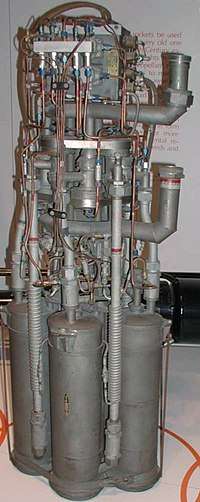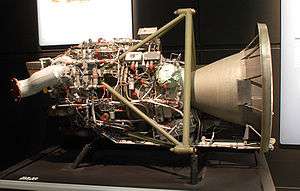Reaction Motors XLR11
The XLR11, company designation RMI 6000C4, was the first liquid-propellant rocket engine developed in the United States for use in aircraft. It was designed and built by Reaction Motors Inc., and used ethyl alcohol and liquid oxygen as propellants to generate a maximum thrust of 6,000 lbf (27 kN). Each of the four combustion chambers produced 1,500 lbf (6.7 kN) of thrust. The engine was not throttleable but each chamber could be turned on and off individually.
 XLR11 rocket engine on display at the National Air and Space Museum | |
| Country of origin | United States |
|---|---|
| Date | 1947–1960 |
| Manufacturer | Reaction Motors Inc. |
| Successor | XLR-99 |
| Liquid-fuel engine | |
| Propellant | LOX / Ethyl alcohol |
| Performance | |
| Thrust | 6,000 lbf (27 kN) |
| Dimensions | |
| Dry weight | 210 lb (95 kg) |
Development
Development of the engine began in 1943. Reaction Motors called the engine "Black Betsy", though informally it was referred to as "The Belching Black Bastard". Its first official designation was the 6000C4, and it was later given the military designation XLR11.[1]
Operational history
The XLR11-RM-5 engine was first used in the Bell X-1. On October 14, 1947, the X-1 became the first aircraft to fly faster than the speed of sound (Mach 1). The XLR11-RM-5 was also used in the X-1A and X-1B, and as a booster engine in the U.S. Navy's D-558-2 Douglas Skyrocket turbojet (where it was designated the XLR8-RM-5).
In 1959 and 1960, while development of a more powerful engine was still underway, a pair of XLR11-RM-13's were used as an interim power plant for the initial flights of the X-15 research aircraft. These engines were boosted to 2,000 lbf (8.9 kN) of thrust per chamber for a total of 16,000 lbf (71 kN). In comparison, the idle thrust of the X-15's XLR99 engine was 15,000 lbf (67 kN). After 24 powered flights, the XLR11 engines were replaced by the new XLR99 engine in November 1960.
The XLR11-RM-13 was also used in the Dryden lifting bodies, and as a booster engine in the Republic XF-91 Thunderceptor turbojet.
Variants
- RMI 6000C4
- Company designation of the LR11 family.
- XLR8-RM-5
- XLR8-RM-6
- (RMI A6000C4-2)
- XLR11-RM-5
- XLR11-RM-13
Specifications (XLR11-RM-5)
Data from:Aircraft engines of the World 1959/60[2]
General characteristics
- Type: quadruple chamber liquid propellant rocket engine
- Length:
- Diameter:
- Dry weight:
- Fuel: ethanol (C2H5OH / EtOH)
- Oxidiser: liquid oxygen (LO2 / LOX)
Components
- Pumps:
Performance
- Thrust: 8,000 lbf (36,000 N)
- Burn time:
See also
- Bell X-1
- North American X-15
- Northrop M2-F2
- Northrop M2-F3
- Northrop HL-10
- Martin Marietta X-24A
- Martin Marietta X-24B
References
- Dupont, Ron (February 24, 2011). "Remembering The Rocketeers". northjersey.com. Retrieved 11 April 2011.
- Wilkinson, Paul H. (1959). Aircraft engines of the World 1959/60 (15th ed.). London: Sir Isaac Pitman & Sons Ltd. p. 40.
External links
- Reaction Motors XLR11 Rocket – National Museum of the United States Air Force
- Dryden Flight Research Center
- X-Planes at Edwards AFB
